Contents
Truffles are marsupials of the order Peciciae, which include the genera Tuber, Choiromy, Elaphomyces and Terfezia. True truffles are only varieties of the genus Tuber. They and edible representatives of other genera are valuable delicacies. Truffles grow underground, reproduce by spores, form mycorrhiza with various plants. They look like small irregularly shaped potato tubers, they have a strong aroma of walnuts or roasted seeds. Mushrooms spread with the help of animals, which find them by smell and subsequently disperse their spores. Steppe truffle is the common name for mushrooms of the genus Terfezia, which includes about 15 varieties. One of them, the African truffle, will be discussed later.
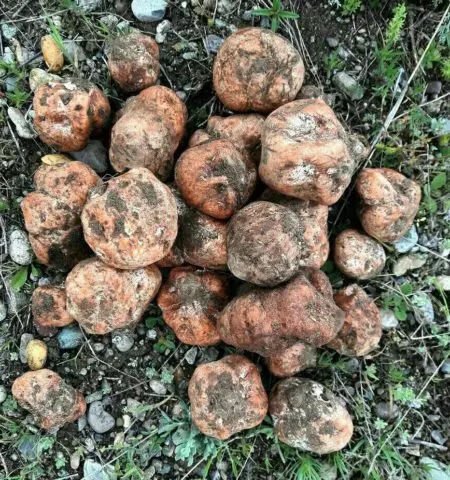
Steppe truffles look like small unhealthy potatoes
What does the steppe truffle look like
African steppe truffle (Terfezia leonis or Terfezia araneria) grows in nests of 3-5 pieces. It looks like a spherical potato of irregular shape, with a smooth or fine-grained surface of a brownish color. Growing mushrooms are dense to the touch, but as they mature, they become softer and more elastic. Fruiting bodies are 2-12 cm in diameter, have a mass of 20-200 g. In color, they are first light, yellowish, in the process of growth they become creamy brown, later darken to brown or black. In the early stages of development, they are located among a dense plexus of mycelium, later they lie freely in the ground, adjacent to it on one side. The pulp of the steppe mushroom is fleshy, juicy, white, creamy or yellowish, turning brown with time, with many winding veins. The fruit shell (peridium) is whitish-pink, 2-3 cm thick. The spore bags are arranged randomly inside the pulp, contain up to 8 ovoid or spherical spores, do not break down into powder when ripe. The steppe truffle has a light mushroom aroma and a pleasant, but inexpressive taste. In terms of quality, it is significantly lower than French, Italian, white, summer truffles.
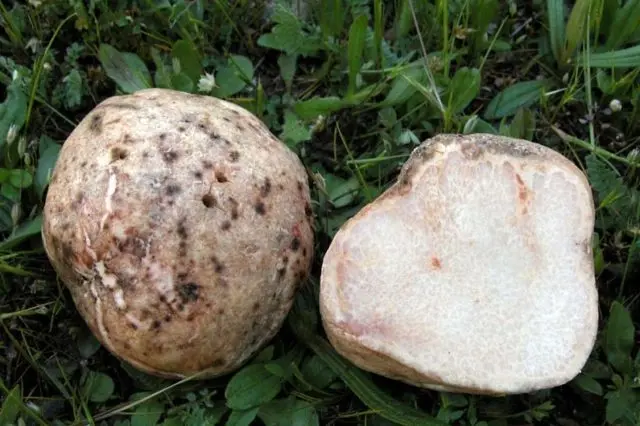
On the cut, creamy flesh with whitish streaks is visible.
Where does the African truffle grow?
The range of the steppe truffle covers arid and semi-arid regions of the Mediterranean, the Arabian Peninsula, North Africa, Southwest Asia, Europe, and the territory of the former Soviet Union. Mushrooms prefer carbonate soils with a high pH. Having formed underground, they rise close to the surface as they grow, so that experienced gatherers can easily find them without the help of specially trained animals. The steppe truffle is adapted to survive in extreme heat and drought. Consists in a symbiotic relationship with herbs and semi-shrubs of the Cistus family. Fruiting from August to November.
Is it possible to eat steppe truffle
The African truffle has a culinary history of over 2300 years. According to the biochemical composition, it does not differ from other mushrooms, it also contains proteins, fats, carbohydrates, vitamins A, B1, B2, PP, C, carotene, dietary fiber. Micro and macro elements are contained in it in small quantities:
- Antioxidants included in a balanced diet, the mushroom can reduce the risk of cancer.
- Substances used in the treatment of senile cataracts in folk and official medicine.
Steppe truffles have a tonic and stimulating effect on the body, favorably affect the immune system and the nervous system.
False doubles
The steppe truffle has twins, the use of which leads to poisoning. It is noteworthy that they are completely safe for animals and are not only food for them, but also medicine.
Deer truffle (Elaphomyces granulatus)
Other names for the fungus are granular elafomyces, parga, parushka. The similarity with the steppe truffle is determined by external signs and the fact that it also grows underground. Fruiting bodies are spherical, with a smooth or warty surface, brown or black in color. The crust on the cut is pink or grayish. The flesh is gray, by the time of ripening it crumbles into spore powder, has the smell of raw potatoes. Deer truffle forms mycorrhiza with coniferous trees. Grows from July to November.
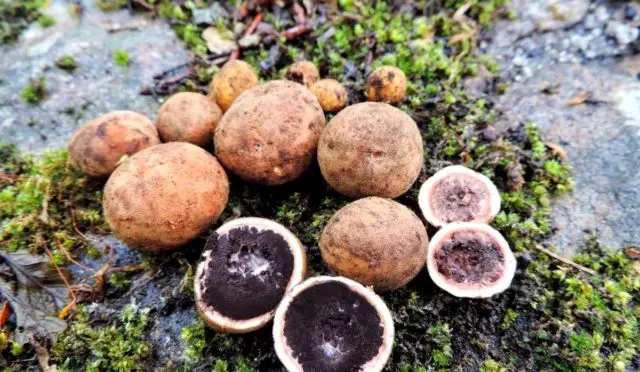
Common puffball (Scleroder macitrinum)
Fruiting bodies are laid as underground, as they grow, they come to the surface. They have a tuberous shape, dense and hard to the touch. The outer shell is yellowish-brown, covered with cracks and brown scales. The pulp of a young mushroom is fleshy, juicy, light. Over time, it darkens from the center to the edge, becomes brown or black-lilac, acquires a sharp unpleasant odor. When the raincoat matures, a crack forms on its top, through which the spore powder comes out. The mushroom is poisonous, its use can be fatal.
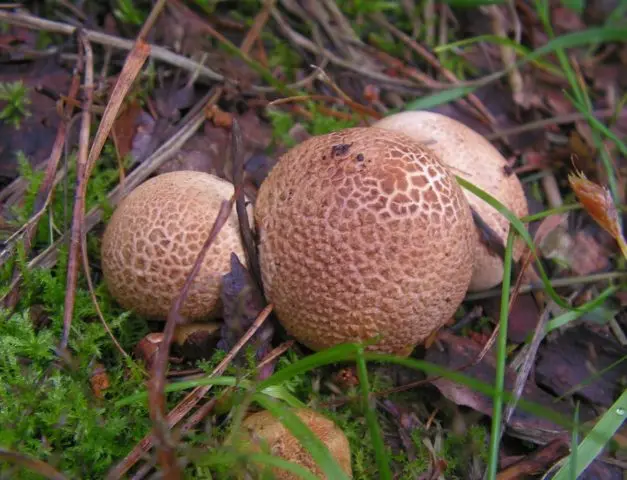
Melanogaster Bruma (Melanogaster broomeanus)
A rare species, listed in the Red Book of the Novosibirsk region. Fruit bodies are irregularly tuberous, up to 8 cm in diameter, brown in color, with a smooth or slightly felted surface. The flesh is brown or brown-black, consists of rounded chambers filled with gelatinous substance. Melanogaster has a pleasant fruity smell. Grows in deciduous forests, lies shallow in the soil under deciduous litter. Listed as an inedible mushroom.
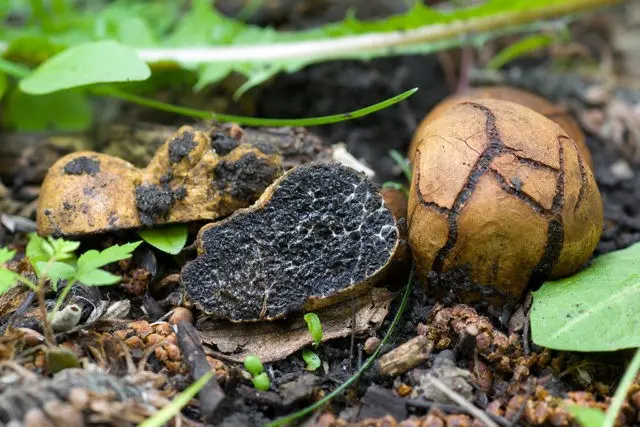
Melanogaster doubtful (Melanogaster ambiguus)
The shape of the fungus varies from spherical to ellipsoid, the outer shell is matte, velvety, grayish brown or olive brown, cracking with age. The flesh is whitish with bluish-black chambers, becoming reddish-brown or black with whitish streaks when ripe. Young specimens exude a pleasant fruity aroma, adults – an unpleasant smell, reminiscent of rotting onions.
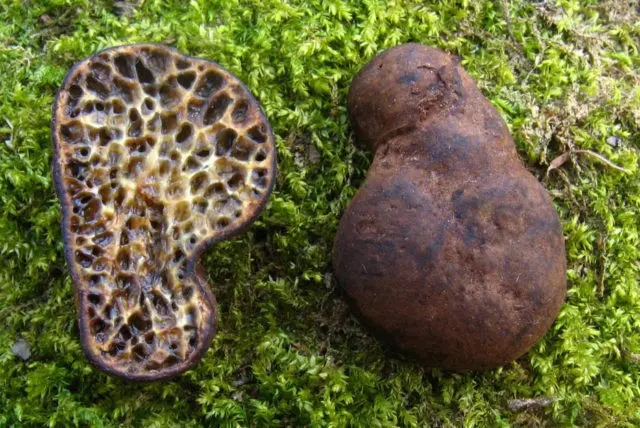
Common rhizopogon (Rhizopogon vulgaris)
Rounded, brownish fruit bodies of rhizopogon up to 5 cm in diameter are found in coniferous forests. Young mushrooms are velvety to the touch, old ones are smooth. The inner part of the fungus is dense, yellowish, sometimes brown-green. The pulp consists of many narrow spore chambers. It is considered edible, but it is recommended to eat young fruiting bodies.
Inexperienced mushroom pickers may mistake young specimens of some types of raincoats, roots, and underground lacquer for a steppe truffle.
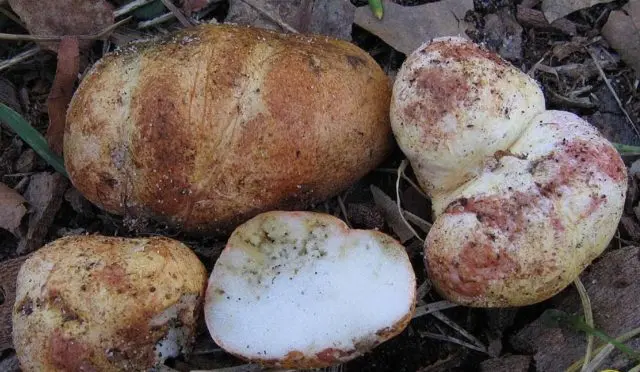
Rules for collection and use
In order to collect African truffles, you must first find them. The places of growth of these fungi are identified by the plants with which they form mycorrhiza – in this case, it is cistus or sunshine. The steppe truffle betrays its presence as a small bump or crack in the soil. The mushroom is dug out with a special narrow spatula, trying not to damage the mycelium. Touching the fruiting body with your hands is highly undesirable, this significantly reduces its shelf life. It should be remembered that truffles grow in nests, if you find one mushroom, you should look for others nearby.
It is used in cooking, medicine and cosmetology. The mushroom can be eaten raw or cooked in any desired way. It is introduced into the composition of sauces, salads, added to soups as a fragrant seasoning. The mushroom does not need to be skinned. It is thoroughly washed, after which it is cut with it or rubbed on a grater.
Conclusion
Steppe truffle is a tasty, healthy, nutritious mushroom with medicinal properties. It is inferior to real truffles in terms of its taste characteristics, but in a number of countries of the world it is valuable only because it is able to exist in conditions of extreme heat and drought. The Bedouin highly value this mushroom and consider it a special gift from God. They call him Sheikh. The African truffle is even mentioned in the Qur’an as a remedy for eye diseases.









